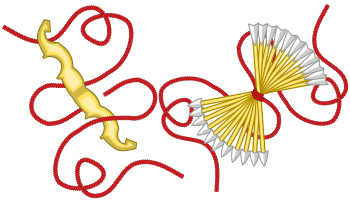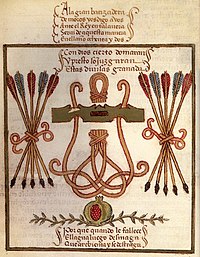This article may be in need of reorganization to comply with Wikipedia's layout guidelines. (December 2020) |

The yoke and arrows (Spanish: Yugo y flechas) or the yoke and the bundle of arrows (Spanish: Yugo y haz de flechas) is a symbolic badge dating back to the dynastic union of Spain's Catholic monarchs Ferdinand II of Aragon and Isabella I of Castile. Subsequent Catholic monarchs continued to use it on their shields to represent a united Spain and symbolize "the heroic virtues of the race".[1]



It was also an allusion to the names of the founding monarchs: Y stood for yugo and for Ysabel (in contemporary spelling) and F stood for flechas and for Ferdinand. The yoke referred to the legend of the Gordian knot, as did Isabel and Ferdinand's motto Tanto monta; the bundle of arrows alluded to the ancient proverb that arrows can be easily broken one by one, but are unbreakable if tied together.
- ^ Wendy Parkins. Fashioning the body politic: dress, gender, citizenship. Oxford, England, UK; New York, New York, USA: Berg, 2002. Pp. 178